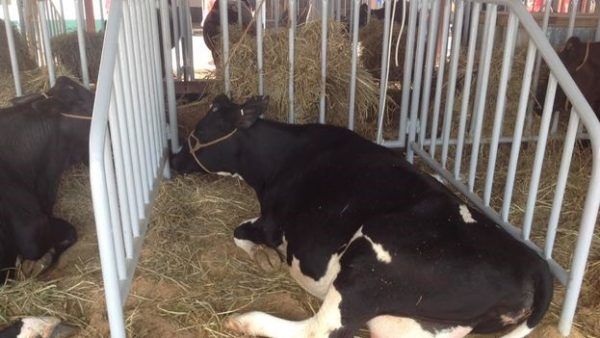
By September, dairy farmers in Villa Clara had delivered only 53% of the milk the Cuban government had been expecting, a total of approximately twenty-one million liters compared to the thirty-nine which contracts had stipulated. The shortfall was reported on Tuesday by the state-run newspaper Granma in an article entitled “Defaults, Paperwork, Transport and Other Ways to ’Cut’ Milk”, which looked at the reasons for supply shortages and rising milk prices.
The problem began in Ciego de Avila where less than half of the expected eighteen million liters has been delivered. The government’s broken promises are making matters worse. In April officials announced an incentive program: it would pay dairy farmers in both hard currency and pesos for every liter they sold to the state over the contract amount. But no hard currency is forthcoming because producers cannot easily open bank accounts to receive payment so the money is not going out.
As the Granma article explains, if a dairy farmer does not meet his target, he gets only 7.50 pesos a liter. But if he exceeds it, he gets 13.00, at least in theory. In the best case scenario, however, the payment is delayed.
“In practice, what’s been happening, for a variety of reasons, is that farmers have to wait a month or more to get paid. Rather than hand it over to the state, it’s more profitable for them to sell it ’on the side,’ where they can get between 15 to 25 pesos. Or they turn it into yogurt or cheese, which also command good prices,” explains one producer quoted in the article.
Roberto Lopez Hernandez, director of the Villa Clara Dairy Products Company, claims in the article that part of the problem is due to delays in signing invoices, which he attributes to Covid-19. According to Betsy Arroyo Rafuls, president of the National Association of Small Farmers in Villa Clara, some producers got their money forty days late, “which obviously disincentivized them.”
Of the 8,000 producers with state contracts, only 1,837 fulfilled their part of the deal. As a result, thousands of liters of milk and other dairy products did not go to the rationed market. Another statistic: of the 281 production outlets in Villa Clara, 177 (or 63%) did not meet their target.
Price increases are just one consequence of milk being diverted to the black market. The government recently decided that people on medically prescribed diets would no longer receive extra rations of milk. And other consumers are replacing dairy products with soy-based yogurt and similar alternatives.
In addition to governmental foot dragging when it comes to paying bills, Granma cites other causes for the disastrous statistics, among them transportation problems. The sub-delegate for livestock in Villa Clara, Miguel Rodriguez, claims the fall in crop prices in the middle of the harvest season caused many truck drivers to leave their jobs; 188 in the province, 36 in Placetas alone. As a result producers have had to pay drivers out of their own pockets to avoid losing their milk.
Dairy farmers also point to shortages of medications — as one farmer notes, “a cow with tick fever doesn’t produce milk” — water and feed as reasons why many cows are malnourished, do not give birth and, even worse, die. Granma argues that 7,434 cows could not be milked due to the drought in July and August.
Rigoberto Rodriguez Fuentes, president of the credit and services cooperative Efrain Hurtado in Manicaragua, is not thrilled with the decision to adopt three different prices for milk. “It was not a great idea. It has created a lot of bureaucracy and red tape, which are not great motivators for farmers who need to be paid upon delivery,” he says.
In his blog Cubaeconomía, Madrid-based Cuban economist Elias Amor breaks down the key points of the Granma article. He cites one of the farmers quoted in the piece, who sums up the situation better than any expert:
“’They thought raising the price of this product a few pesos would automatically solve the livestock problem and milk deliveries would automatically increase, which is not the case.’ As we have long said in this blog, if [President] Diaz-Canel listened to Cuban peasants more, he would find out what has to be done to produce more,” Amor writes. He adds that technical and production realities, as well as market forces, are immune to many of the decisions the government makes.
“Price controls, late payments and bureaucratic delays are obstacles impacting Cuban milk production and preventing the needs of consumers and industry from being met. Agriculture is the economic sector most dependent on the state. Has the time perhaps come for restructuring it to operate freely?” asks Amor.
The milk crisis goes back a long way. In recent decades the government has found it very difficult to provide the” little glass of milk” it promised the Cuban consumer. The situation has grown more acute in recent months. Today it’s Villa Clara; two weeks ago it was Ciego de Avila.
Just a month ago it was reported that no dairy farmer in Camaguey province, the island’s leading livestock producer, had delivered more than eight liters of milk to the state. When the Evelio Rodriguez Curbelo cooperative in Jimguayu managed to produce one million liters of cow’s milk, state media outlets portrayed it as a great success. However, if you take into account the number of cattle involved, the result is devastating, barely 1.1 liters per day per animal compared to 25 for a cow in Spain.

























